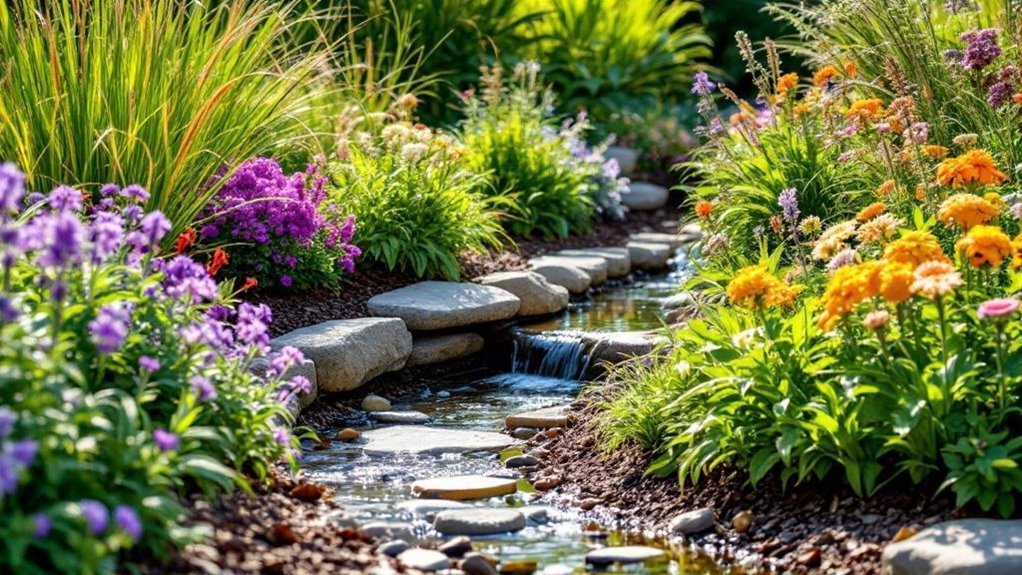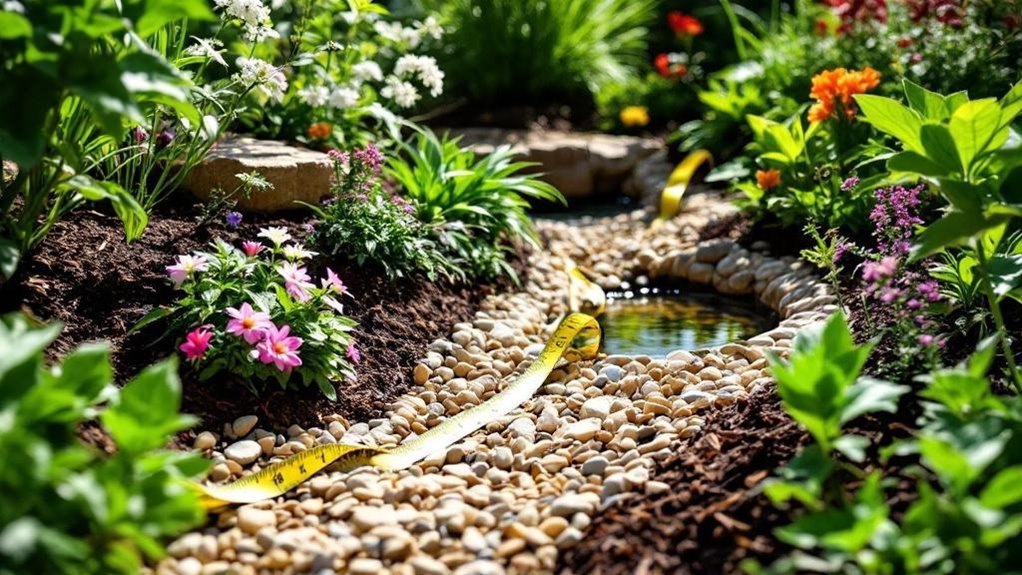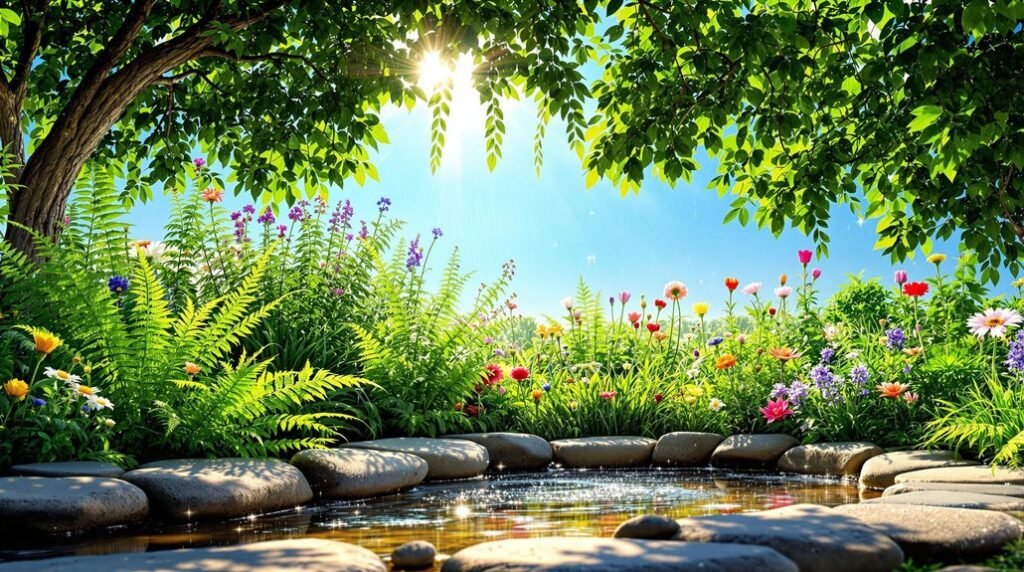If your driveway often floods after a heavy rain, you might want to contemplate creating a rain garden to manage that runoff naturally. By capturing and filtering stormwater, rain gardens not only reduce erosion but also support local wildlife. You’ll need to think carefully about location, size, and plant selection to make it work effectively. Understanding these key factors will help you design a garden that truly benefits your landscape and environment.
Understanding Rain Gardens
How can you manage stormwater effectively in your yard? A rain garden offers a smart solution. It’s a shallow, planted depression designed to capture and absorb rainwater runoff, usually placed in lower spots where water naturally collects.
Unlike traditional lawns, rain gardens soak up about 30% more rainwater, reducing flooding and runoff problems. To build one, you’ll need an inflow area for water, a basin filled with soil and native plants, and an overflow system to handle heavy rains.
Native plants are key—they thrive in your local climate, filter pollutants, and support wildlife. Just remember to position your rain garden at least 10 feet away from your house foundation and size it according to the area draining into it.
This careful planning guarantees it works efficiently.
Benefits of Installing a Rain Garden
Although rain gardens might seem like simple landscaping features, they offer powerful benefits for your property and the environment.
Rain gardens may appear simple but provide significant environmental and property benefits.
Installing one helps manage stormwater naturally, enhancing your landscape while protecting local ecosystems.
Here are three key benefits you’ll enjoy:
- Improved Water Management: Rain gardens absorb up to 30% more rainwater than traditional lawns, reducing flooding and protecting your water supply from contamination.
- Cost-Effective Environmental Impact: They filter pollutants from runoff, improving water quality in nearby streams and rivers without costly infrastructure.
- Enhanced Property Value and Biodiversity: Besides beautifying your yard, rain gardens attract native wildlife, supporting biodiversity and increasing your property’s market appeal.
Key Components of a Rain Garden

When you create a rain garden, you’ll need to include several key components that work together to manage stormwater effectively.
Start with an inflow area to capture runoff and direct it into a basin where water collects and soaks in. Use amended soil enriched with compost to support healthy plant growth while meeting the garden’s water needs. Beneath this, a drainage substrate layer of sand or gravel guarantees proper infiltration.
Add mulch, about 2-3 inches thick, to retain moisture, prevent erosion, and suppress weeds. Incorporate native plants that naturally filter and absorb rainwater. For areas with fast runoff, rocks can slow water flow and reduce erosion.
Finally, size your rain garden to be 5-10% of surrounding impervious surfaces to handle stormwater efficiently.
Selecting the Ideal Location
Where exactly should you place your rain garden to maximize its effectiveness? Start by identifying low-lying areas in your yard where water naturally collects, especially spots receiving water from a downspout. This guarantees your garden captures stormwater efficiently.
Next, consider these key points:
Keep your rain garden safe and effective by avoiding foundations, utilities, and trees, and maintaining distance from wellheads.
- Position the garden at least 10 feet away from your home’s foundation to prevent water damage.
- Avoid placing it over underground utilities or near mature trees to protect roots and pipes.
- Ascertain the site is at least 100 feet from wellheads to safeguard groundwater quality.
Also, test the soil’s infiltration rate—it should absorb water at least 0.5 inches per hour.
Choosing the right location helps your rain garden thrive and manage runoff effectively.
Calculating the Appropriate Size

Since your rain garden’s size directly affects its ability to capture runoff, you’ll want to calculate it based on the area of impervious surfaces like roofs and driveways that drain into it.
Start by measuring the total square footage of these surfaces, then multiply that number by 5-10% to find the ideal garden size. For example, if you have 3,000 square feet of impervious area, your rain garden should be around 300 square feet.
When creating a rain garden, position it at least 10 feet from building foundations and in low-lying spots to intercept runoff efficiently.
Also, verify your soil infiltrates at least 0.5 inches per hour. Installing overflow features like berms or underdrains can ease sizing concerns by managing excess water effectively.
Choosing Native Plants for Your Rain Garden
After sizing and placing your rain garden, selecting the right plants will help it thrive and function effectively.
Native plants are your best bet since they’re adapted to local conditions, need less water, and support local wildlife.
Choosing native plants is smart—they thrive naturally, conserve water, and attract local wildlife.
Here’s how to choose wisely:
- Prioritize a mix of water-loving plants like Cardinal Flower for the garden’s center and drought-tolerant ones like Daylilies near the edges to balance moisture.
- Incorporate a variety of perennials, grasses, and shrubs to boost biodiversity and soil health by adding organic matter naturally.
- Use resources like txsmartscape.com to find native plants suited to your region’s sunlight, moisture, and soil type.
Step-by-Step Construction Process
Start your rain garden by marking its outline with string or spray paint, making sure to place it at least 10 feet from your home’s foundation in a low spot that can catch runoff. Next, dig a 6 to 8-inch depression with a raised bank to retain water. Add a drainage substrate like sand or gravel, then a soil layer amended with compost. Plant native vegetation suited to moisture variations, and finish with a 2-3 inch layer of mulch to control erosion and retain moisture.
| Step | Key Action |
|---|---|
| 1. Outline | Mark area 10 ft from foundation |
| 2. Excavation | Dig 6-8 inches, create bank |
| 3. Layers & Planting | Add substrate, soil, mulch, plants |
Different types of mulch support plant growth and water management effectively.
Maintaining Your Rain Garden
To keep your rain garden functioning well, you’ll need to inspect it regularly for erosion, sediment buildup, and plant health. Effective maintenance guarantees your garden absorbs stormwater efficiently and stays vibrant.
Focus on these key tasks:
- Maintain a 2-3 inch mulch layer to control weeds, retain moisture, and protect roots during dry periods.
- Water new plants consistently until established, but avoid overwatering; check that water infiltrates within 24-48 hours after rain.
- Remove invasive species promptly and conduct seasonal pruning, deadheading, and replace dead plants to support healthy growth.
Frequently Asked Questions
How Do I Direct Water to a Rain Garden?
You’ll want to guide water by positioning the rain garden downhill from downspouts or runoff paths. Create gentle slopes or swales, use splash blocks, and make certain overflow outlets to handle heavy rain without flooding.
How to Build a Rain Water Garden?
Imagine capturing rain’s gentle dance in your garden. You’ll dig a shallow basin, line it with gravel, enrich soil with compost, plant natives in moisture zones, and mulch well to transform runoff into vibrant life.
What Are the Disadvantages of a Rain Garden?
You might face challenges like regular maintenance, potential standing water attracting pests, high installation costs, and soil drainage issues. Also, rain gardens aren’t ideal for every property, especially if space or terrain limits their effectiveness.
How to Collect Rain Water for Your Garden?
You can collect rainwater by installing rain barrels under downspouts. Use a first flush diverter to keep water clean, comply with local rules, and regularly clean your system to prevent mosquitoes and maintain water quality.
Final Thoughts
Creating a rain garden is like giving your yard a natural sponge—it soaks up runoff, just like how Sarah’s little garden stopped flooding after a heavy storm. By choosing the right location, sizing it properly, and picking native plants, you’ll transform water waste into a thriving oasis. With some care and patience, your rain garden won’t just beautify your space; it’ll protect your home and the environment, one drop at a time.
